Book: The Lonely Doll
Author: Dare Wright
Type of Book: Children’s fiction, photography, inadvertently creepy
Why Do I Consider This Book Odd: Because it’s only odd if you’re a grown-up.
Availability: Initially published in 1957, it went out of print for a while but the copyright was renewed in 1985. I cannot find a publication on my copy but it was published by the Sandpiper division of Houghton Mifflin, and is visually identical to copies you can purchase new:
Comments: When I was bouncing around the idea of trying to get out of my rut and rev my writing engine for Halloween, my friend and PUBLISHER WHO IS STILL PATIENTLY WAITING FOR MY FINISHED WORK ON MANIFESTOS, Chip Smith, mentioned that last year’s foray into children’s books was interesting and made a few suggestions on other works I could pursue. He didn’t mention The Lonely Doll, but his enthusiasm for the topic reassured me I was on the right path. So here we are, discussing this pretty but potentially alarming book.
This book was not a part of my landscape as a child. It wasn’t just that dolls didn’t frighten me – I never set eyes on this book until very recently. I first became aware of the book when actress Famke Janssen filed a police report believing that someone had broken into her apartment and did nothing but leave behind a copy of The Lonely Doll. Police were highly skeptical about her claims, though they never charged her with making a false police report because they believe Janssen believed this happened and was sincere when she made the claims. There were no signs of entry, the security cameras at her apartment never showed a break-in attempt, and inside the book the police found a to-do list that was written by Janssen herself. It was the book that grabbed my attention more than the notion that an actress would make up such a story because regardless of whether or not the break-in really happened, I’m still left wondering about the significance of the book and why anyone, Janssen or an intruder, would feel the book conveyed malice or ill-intent.
The story was not enough to provoke me into purchasing The Lonely Doll, but over the last couple of years, the book has come up on various list sites (Top Ten Sewer Disasters, Five Reasons Why You Personally Are Worse Than Hitler, etc.) when the topic of terrifying things from childhood make their rounds. I’m unsure how all my years in the book arena, from childhood to a year ago, passed without me seeing this book but I suspect it’s the case that I tune out that which is not relevant to my interests. I very quickly passed from picture books with minimal text to books marketed to teens and adults, and when I was still reading books for little kids, I liked drawings more than photos. I also tended toward smaller books, like the Little Golden Books. So the uneasiness this book caused some readers and still causes adults who investigate the book wasn’t something I experienced either as a child or in retrospect as an adult who read this book as a child.
The awkwardness in the final sentence in the above paragraph is intentional because it’s important to narrow down who is upset by this book and why. From what I have seen, children don’t really respond poorly to this book, or at least the children who were the target market for this book during its heyday, and that audience is mostly women who now are between 40 and 70 years old, though younger readers of the book pop up from time to time. I walked an uneasy line when looking into this book because I genuinely don’t want to know much about books, even fluffy picture books, before I look into them for myself but one statement came up so often that it was unavoidable, words to the effect of:
“I didn’t realize how creepy this book was until I found my old copy in a box in the attic and thumbed through it for the first time in decades.”
Though I was terribly interested in what sparked such a retrospective reaction, I managed to stop reading before these (mostly) women explained themselves. I’m glad I did because I was able to see the book through mostly uninfluenced eyes and, in the end, my reaction as an adult who did not read this book as a child is similar to the women who did. When I went back to review their reactions, there one one large commonality that I will discuss in a moment, but mostly we all felt a strange uneasiness that is hard to pin down. And though I feel I must emphasize that this is a book that is despised by the woke among us, the fact is that this is not a wicked or deliberately unpleasant book. It’s a relic of its time and possibly a very useful tool in armchair psychoanalyzing the author, a favorite pastime of mine. Unless one was a child who was very frightened of dolls in general, this book is unlikely to be that upsetting. More modern children may have a negative reaction because of changing mores regarding appropriate discipline for children but much can be said for any book about children written before the 1970s.
Though this is a very well-conceived, well-executed book, it’s an emotionally taxing book for an adult to read.
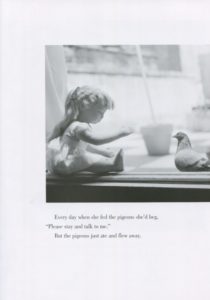 Little Edith, the Lonely Doll, is terribly lonely, to the point that she begs pigeons to stay and be her friend but all they do is eat the bread crumbs she leaves them and fly away. When Mr. Bear and Little Bear show up, it is literally an answer to this forlorn toy’s prayers, and that it is visually adorable helps draw you in.
Little Edith, the Lonely Doll, is terribly lonely, to the point that she begs pigeons to stay and be her friend but all they do is eat the bread crumbs she leaves them and fly away. When Mr. Bear and Little Bear show up, it is literally an answer to this forlorn toy’s prayers, and that it is visually adorable helps draw you in.
The bears and Edith quickly settle into a domestic life that involves lots of playing, mischief and even vacations to the beach. All is right in the world until one rainy day, Edith and Little Bear find themselves at loose ends because it is raining and they cannot go outside. Mr. Bear is not there – running errands one presumes – and the two decide to explore the house, finding a wardrobe full of clothes and shoes and a dressing table covered in cosmetics, perfume and jewelry.
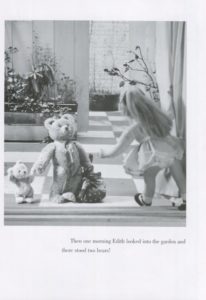 This scene is compelling for little children who enjoy dressing up and especially compelling given the grown-up nature of the items they find on the dressing table, like jewelry and expensive perfume. The two play dress-up until Little Bear dares Edith to put on lipstick. She demures, certain Mr. Bear would be angry if he found out. Little Bear is feeling rebellious and takes the lipstick and writes, with a nod to Christopher Robin, no doubt, “Mr. Bear is just a silly old thing.” He then hands the lipstick to Edith, egging her on. She puts on the lipstick, playing along with Little Bear’s antics. Of course this is when Mr. Bear walks in and is appalled that she is wearing lipstick, something he believes she knows better than to do.
This scene is compelling for little children who enjoy dressing up and especially compelling given the grown-up nature of the items they find on the dressing table, like jewelry and expensive perfume. The two play dress-up until Little Bear dares Edith to put on lipstick. She demures, certain Mr. Bear would be angry if he found out. Little Bear is feeling rebellious and takes the lipstick and writes, with a nod to Christopher Robin, no doubt, “Mr. Bear is just a silly old thing.” He then hands the lipstick to Edith, egging her on. She puts on the lipstick, playing along with Little Bear’s antics. Of course this is when Mr. Bear walks in and is appalled that she is wearing lipstick, something he believes she knows better than to do.
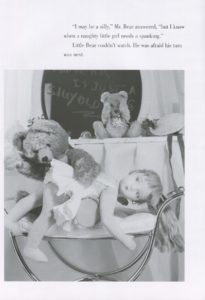 And this is where most people focus their unease with the book. Mr. Bear spanks her.
And this is where most people focus their unease with the book. Mr. Bear spanks her.
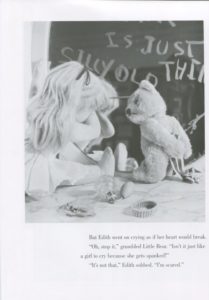
After her spanking, still defiant, Little Bear still stands by his “silly old thing” comment but Edith breaks down into sobs, terrified that Mr. Bear will leave her and take Little Bear with him if they continue being bad. Little Bear, immediately chastened, soothes Edith and together they clean up the mess and then seek out Mr. Bear for absolution.
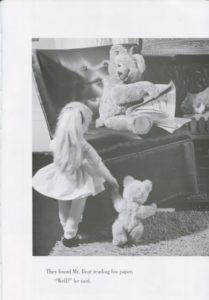 Mr Bear, who was reading the newspaper on the couch like a furry Ward Cleaver, was waiting for an apology and willing to forgive them both of the heinous crime of acting like children.
Mr Bear, who was reading the newspaper on the couch like a furry Ward Cleaver, was waiting for an apology and willing to forgive them both of the heinous crime of acting like children.
There’s a lot in this book that adult me finds unpleasant. The spanking thing is kind of nasty but let’s bear in mind that in the 1950s spanking was the norm and perhaps being spanked over the knee of a teddy bear isn’t the worst thing that could happen to a pretty, unsupervised doll. But the rest of the book is disturbing outside the realms of relativist parenting techniques.
Like, who the hell does this bear think he is and why does he think he has the right to spank this doll? If Edith is a doll, where is the child who plays with her? Where are the other toys? If she’s a stand-in for a little girl, where are her parents? Why was this doll left utterly alone in this house that she hasn’t even explored enough on her own to discover the dressing room before the bears showed up? These are real toys interacting with real objects, which gives the reader a voyeuristic feeling as they watch photos that maybe shouldn’t be shown to others.
The author of this blog uses The Lonely Doll as a graphic stand-in for the way adults view spanking of children versus the spanking of adults and wonders if people are upset about Edith’s spanking because they are blurring the lines between childish fantasies about the secret lives of toys and their own reactions to past and present spankings in real life. The author finds fault with some of the negative reaction to this book because the adult is viewing the punishment from the lens of receiving it as an adult, and even if I may not agree, I can see the logic. Whether or not there is anything sexual about spanking Edith, and plenty think that there is indeed an erotic element, the fact that spanking children was not taboo when this book was written and photographed is important.
But we also need to ask ourselves what this spanking was meant to convey. I’m deliberately shying away from discussing spanking in media aimed at children because up until the 1970s, most cases of spanking in children’s media at worst were portrayed as a necessary evil and the children receiving such spankings – think of Tom Sawyer and similar – were just fine. There were some rather Dickensian looks at abuse but the wholesale beating of a child was generally not seen as appropriate discipline and was a thing apart from spanking. Moreover, the spankings were not the larger message of such books. They seldom were the actual message of any media that presented spanking. Through the 1980s, media as a whole, including advertising, didn’t shy away from spanking – a trope that seems fairly negative – as they sought to sell their products because the message the ads were conveying was so outrageous as to be culturally understood to be outrageous, or they sought to avoid spanking altogether. Ads featured children and adults alike being spanked. When it was a child receiving the punishment, the message the ads conveyed was that use of their product could avoid discipline issues that led to spanking, which was a thing a good parent would want.
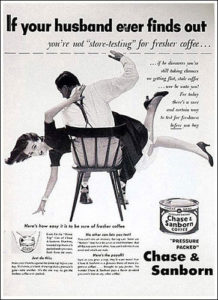 As for spanking adults, most of it was tongue-in-cheek, slyly implying that a wife might be a slattern or slipshod in the hopes of receiving an erotic spanking over the knee of her husband.
As for spanking adults, most of it was tongue-in-cheek, slyly implying that a wife might be a slattern or slipshod in the hopes of receiving an erotic spanking over the knee of her husband.

Sometimes the script was flipped and the man got the spanking but most of those ads were deliberate inversions of previous ads and it was difficult finding an “organic” use of a woman spanking a man. This one comes very close. The man in this ad is not being spanked but her dog bit his ass, ruined his pants, and he ends up humiliated and sprawled over her knee with a pained posterior. The posture of this ad is of submissive acceptance of authoritative dominance and her arm is raised up above her head in a perfect mimic of spanking. Incidentally, this whole ad encapsulates why the seventies was so very awful.

It’s remarkable how many movie posters featured spanking. These ads invariably show how fun spanking a full-grown woman is, especially if there’s at least one person watching as it happens. Spanking was “racy.”
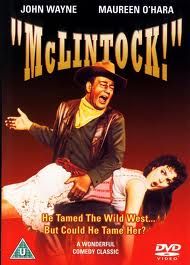
Women evidently wanted to be “tamed” by old screaming men, and, again, it was all in fun, even if the dude looked downright homicidal like John here. This is a nicer version of the poster – another shot has a crowd gathered, presumably to cheer him on as he wrecked this woman for sass or maybe she put on some lipstick, too.
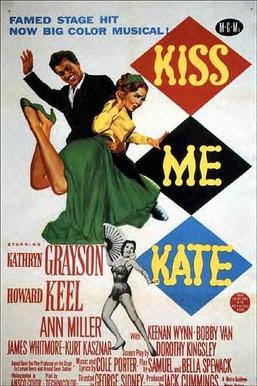
While few modern women will look at these ads and find them wholly amusing, it’s hard to get too worked up over adult women in heels and shellacked hair getting spanked in perfectly posed technicolor.
But mostly these images are deprived of miserable impact because of how fucking stupid they are. Spanking a wife for not “store testing” coffee or implying drug store shampoo will help a modern woman assert disciplinary dominance are on their faces really stupid premises, deliberately stupid, in fact. Spousal abuse was less discussed when these ads ran and physical violence in relationships was a societal ill that still plagues us but the audiences then, as well as now, understand that these ads are hyperbolic, and that only a lunatic would hit their spouse over supermarket coffee and lunatics were not the target audiences for these products or films. Audiences today might see far more violence in these images than a 1960s housewife but within the times these ads ran, the audience understood the message being conveyed – buy fresh coffee, get the right shampoo, we can’t show you pent up perverts penetration on film so spanking will suffice. At no time is the actual message, “Beat your spouse.”
As an aside, I found this image when searching for spanking images.
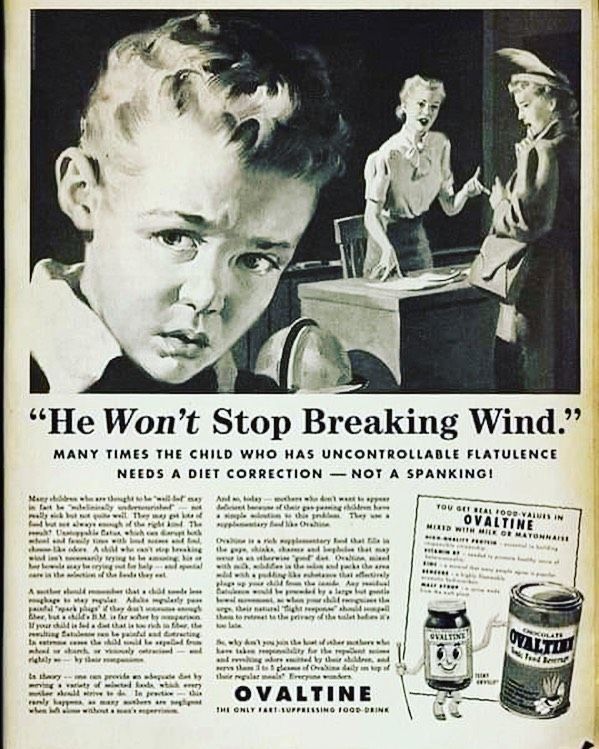 Our grandparents were absolute madmen. Jesus Christ, the kid is farting so often that his teacher has to get involved, dragging his mom into class and everything. But helpful Ovaltine saves the day, proving that the boy isn’t a bad kid, farting up the place on purpose. No, the problem is with the parents since dad leaves his idiot wife alone to her devices and without him there to instruct her, she evidently feeds her son like a goat at a petting zoo. But as remarkably awful as this ad is, the message is to avoid spanking your kid by reducing his flatulence.
Our grandparents were absolute madmen. Jesus Christ, the kid is farting so often that his teacher has to get involved, dragging his mom into class and everything. But helpful Ovaltine saves the day, proving that the boy isn’t a bad kid, farting up the place on purpose. No, the problem is with the parents since dad leaves his idiot wife alone to her devices and without him there to instruct her, she evidently feeds her son like a goat at a petting zoo. But as remarkably awful as this ad is, the message is to avoid spanking your kid by reducing his flatulence.
Back to the book. What is the message behind Edith’s spanking? The doll in this book is one of the most emotionally desperate child characters one can find outside of depictions of war. She’s utterly alone, bereft and literally praying for relief from her torment of loneliness. Then two bears – an adult and a peer – arrive and a weird power balance develops wherein Edith is now subject to the will of a masculine parental figure and the whims of her brother-bear can result in this adult bear hitting her (because Little Bear egged that shit on, for sure). For Edith, the power of the spanking is not that she has disappointed her father figure because she engaged in behavior that any loving caretaker would want to correct, but rather the fear that a spanking is the prelude to future abandonment, a fate she will do anything to avoid.
The message can vary but it boils down to variations of a child learning appropriate boundaries and trusting that bad behavior will not result in parental abandonment. These two do not have such a boundary set in place, so shown when Edith is spanked and this resulted in her sobbing from fear of being alone again.
And let’s discuss how she got spanked by a random male doll who showed up one day to live in her home. I do not yet know much about Dare Wright though I hope to have her biography finished today so I can discuss it next, but I guarantee you many young girls whose mothers remarried after divorce or just moved their lovers into the house understand a message very specific to their lives. One day, a male figure whose arrival and possible departure has nothing to do with you or your wants, has physical and social control over you. How many abusive stepfathers were seen as Mr. Bear spanked this emotionally shattered doll? For many adults, childhood is a horror they compartmentalize until they are old enough to cope with it all and I can see very easily how an adult woman can see herself in this doll and remember being a child who was not treated fairly and who feared being left behind more than physical violence.
But you don’t even have to have this specific memory to feel uneasy about a book that features a stand-in for a little girl who begs pigeons to stay with her and talk to her. When confronted with this book, you see dolls interacting in a human environment, standing in for humans. There is a reality to this book that I did not encounter in my Little Golden Books. It is very easy to assign Edith a human role even though she is clearly not a real little girl because the rest of the book is very real. Plus the environment is clean, pretty and the dolls themselves are very cute. A sad little girl is finally given a sort of family and then BOOM! The goddamn big bear is apparently looking right up her dress as he spanks her and she descends into a fit of sobbing despair. That they seem like they’ve mended fences at the end is nice, but that is not the ebb and flow of childhood. It takes a long time to overcome the misery of years of loneliness and fear. The reality of this book mirrors the reality of the unstable nature of childhood itself, where lessons have to be learned over and over and children don’t always spring back.
Dare Wright produced eighteen other books in the Lonely Doll series (one features a kitten and another features Edith kidnapped and tied to a tree), and this book still routinely makes “Best of” lists for children’s books in defiance of how adults may feel about it. Clearly the message children receive from this book, even modern little children, is very different than mine. I don’t know what they see when they read this book but the beautiful photography, cuddly bears, pretty doll, the allure of the make-up and high heels during dress-up all likely play a role in the enduring interest some children have with this book series.
But I still wonder, what message was it that Dare Wright wanted to convey? What caused her to create such a sad, needy character? Did she even realize Edith was needy and miserable? Why did she create a scenario wherein a doll is spanked by another doll in a genuine attempt at discipline? Did she really think Edith deserved a spanking for something so minor? Was the scene a touching look at a father’s attempt to tame an unruly child, or was there something far more malignant that only distance from childhood can show us? Will any of this information help us understand why this book was involved in an actress’s presumably delusional belief someone planted the book in her home?
We’ll find out in my next entry. Until then, share with me any books you read as a child that now as an adult freak you out.










